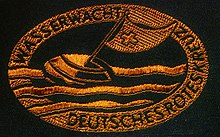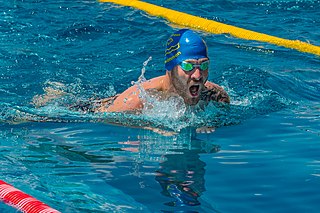
Swimming is the self-propulsion of a person through water, or other liquid, usually for recreation, sport, exercise, or survival. Locomotion is achieved through coordinated movement of the limbs and the body to achieve hydrodynamic thrust that results in directional motion. Humans can hold their breath underwater and undertake rudimentary locomotive swimming within weeks of birth, as a survival response.

Drowning is a type of suffocation induced by the submersion of the mouth and nose in a liquid. Most instances of fatal drowning occur alone or in situations where others present are either unaware of the victim's situation or unable to offer assistance. After successful resuscitation, drowning victims may experience breathing problems, vomiting, confusion, or unconsciousness. Occasionally, victims may not begin experiencing these symptoms until several hours after they are rescued. An incident of drowning can also cause further complications for victims due to low body temperature, aspiration of vomit, or acute respiratory distress syndrome.
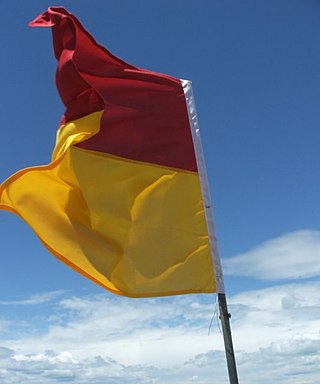
A lifeguard is a rescuer who supervises the safety and rescue of swimmers, surfers, and other water sports participants such as in a swimming pool, water park, beach, spa, river and lake. Lifeguards are trained in swimming and CPR/AED first aid, certified in water rescue using a variety of aids and equipment depending on requirements of their particular venue. In some areas, lifeguards are part of the emergency services system to incidents and in some communities, lifeguards may function as the primary EMS provider.

The butterfly is a swimming stroke swum on the chest, with both arms moving symmetrically, accompanied by the butterfly kick. While other styles like the breaststroke, front crawl, or backstroke can be swum adequately by beginners, the butterfly is a more difficult stroke that requires a good technique as well as strong muscles. It is the newest swimming style swum in competition, first swum in 1933 and originating out of the breaststroke.

The German Life Saving Association is a relief organization for life saving in Germany. The DLRG is the largest voluntary lifesaving organization in the world.
Human swimming typically consists of repeating a specific body motion or swimming stroke to propel that body forward. There are many kinds of strokes, each defining a different swimming style or crawl.

Swimfins, swim fins, diving fins, or flippers are finlike accessories worn on the feet, legs or hands and made from rubber, plastic, carbon fiber or combinations of these materials, to aid movement through the water in water sports activities such as swimming, bodyboarding, bodysurfing, float-tube fishing, kneeboarding, riverboarding, scuba diving, snorkeling, spearfishing, underwater hockey, underwater rugby and various other types of underwater diving.

The Wasserwacht is a German lifeguard service. It is one of the five voluntary societies of the German Red Cross. The Wasserwacht is a non-profit organization made up of on volunteers.
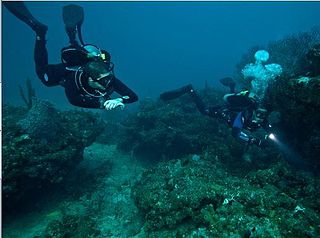
Finning techniques are the skills and methods used by swimmers and underwater divers to propel themselves through the water and to maneuver when wearing swimfins. There are several styles used for propulsion, some of which are more suited to particular swimfin configurations. There are also techniques for positional maneuvering, such as rotation on the spot, which may not involve significant locational change. Use of the most appropriate finning style for the circumstances can increase propulsive efficiency, reduce fatigue, improve precision of maneuvering and control of the diver's position in the water, and thereby increase the task effectiveness of the diver and reduce the impact on the environment. Propulsion through water requires much more work than through air due to higher density and viscosity. Diving equipment which is bulky usually increases drag, and reduction of drag can significantly reduce the effort of finning. This can be done to some extent by streamlining diving equipment, and by swimming along the axis of least drag, which requires correct diver trim. Efficient production of thrust also reduces the effort required, but there are also situations where efficiency must be traded off against practical necessity related to the environment or task in hand, such as the ability to maneuver effectively and resistance to damage of the equipment.

Swimming lessons are the process of learning to swim. In most countries there is a definition of a number of swimming levels that are reached in the process of the curriculum. The respective certificates of swimming tests are required for further training in aquatic abilities. Many countries have defined a minimum swimming level that children should reach by the end of primary education, in most cases with the help of school swimming classes being part of the normal curriculum.

Rescue swimmer is a designation given to rescue specialists, most commonly in the service of the military. Rescue swimmers usually are charged with the rescue, assessment, and rendering of medical aid to persons in distress in the sea, on the land, or in the air. This highly specialized position is extremely challenging.

The German Armed Forces Badge for Military Proficiency is a decoration of the Bundeswehr, the armed forces of the Federal Republic of Germany.
Combat side stroke or CSS is a variation of the side stroke that was developed by and taught to the United States Navy SEALs. The Combat Swimmer Stroke was developed for the United States Navy Seals by Former Navy SEAL Stew Smith (CSCS) and Terry Laughlin of Total Immersion Swimming.
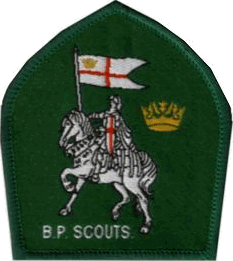
The St. George's Award is the highest youth award achievable in the Senior Scouts section of the Baden-Powell Scouts' Association.
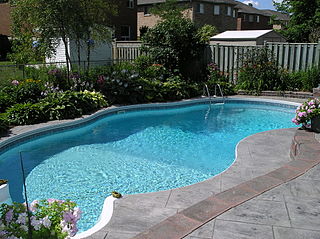
A swimming pool, swimming bath, wading pool, paddling pool, or simply pool, is a structure designed to hold water to enable swimming or other leisure activities. Pools can be built into the ground or built above ground, and may be found as a feature aboard ocean-liners and cruise ships. In-ground pools are most commonly constructed from materials such as concrete, natural stone, metal, plastic, or fiberglass, and can be of a custom size and shape or built to a standardized size, the largest of which is the Olympic-size swimming pool.
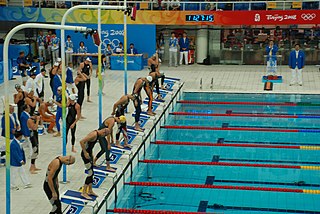
Swimming is an individual or team racing sport that requires the use of one's entire body to move through water. The sport takes place in pools or open water. Competitive swimming is one of the most popular Olympic sports, with varied distance events in butterfly, backstroke, breaststroke, freestyle, and individual medley. In addition to these individual events, four swimmers can take part in either a freestyle or medley relay. A medley relay consists of four swimmers who will each swim a different stroke, ordered as backstroke, breaststroke, butterfly and freestyle.

The front crawl or forward crawl, also known as the Australian crawl or American crawl, is a swimming stroke usually regarded as the fastest of the four front primary strokes. As such, the front crawl stroke is almost universally used during a freestyle swimming competition, and hence freestyle is used metonymically for the front crawl. It is one of two long axis strokes, the other one being the backstroke. Unlike the backstroke, the butterfly stroke, and the breaststroke, the front crawl is not regulated by the FINA. This style is sometimes referred to as the Australian crawl although this can sometimes refer to a more specific variant of front crawl.
The Dutch Military Proficiency Badge is a military badge offered by the Royal Netherlands Army.
The German snorkeling badge is a badge awarded for proficiency in snorkeling. It functions as a preparation for scuba diving certification courses. The badge is awarded either by the DLRG or the Wasserwacht of the German Red Cross.
The German swimming badge is awarded by members of the Wasserwacht of the German Red Cross and the DLRG for completing certain requirements and for demonstrating swimming skills.



